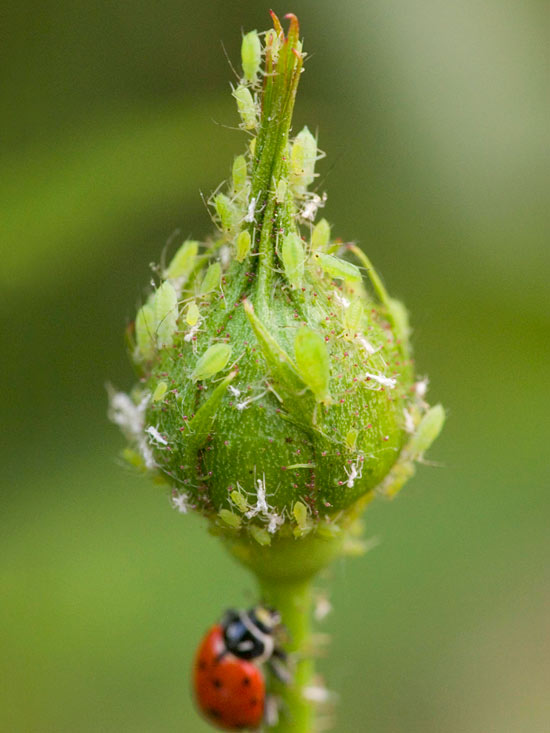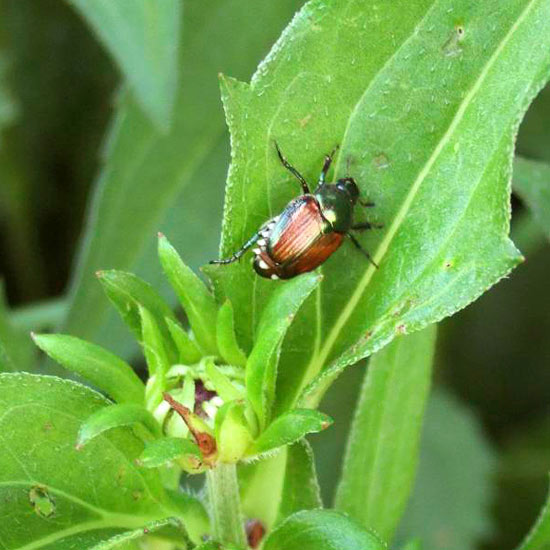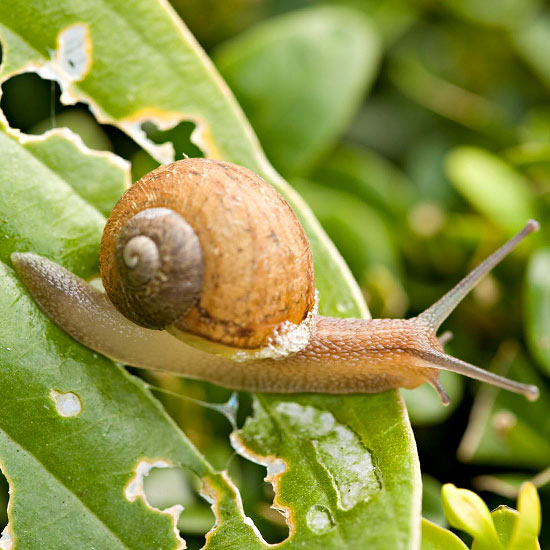





Nothing can ruin a good day in the garden like a plant overrun with pests. How you deal with the problem depends on what has invaded your yard. Here are common garden pest control methods for a wide range of insects.
continue reading below
What they look like: Pear-shape and soft-bodied, aphids can either be winged or wingless; a white cottony form also attacks fruit trees.
Plant damage: Aphids are typically found clustering on the growing tips of stems, where they suck sap, distort leaves and flowers, and spread plant viruses. In addition, aphids secrete clear, sticky honeydew, which attracts ants.
Pest control method: Ladybugs and other beneficial insects typically bring aphids under control. In addition, a strong spray of water from a hose can knock them off plants. Insecticidal soap works, too.
Learn more about aphids.
What they look like: Caterpillars and worms are the larval stage of moths and butterflies, which makes them trickier to deal with because many will turn into beautiful butterflies.
Plant damage: Caterpillars and worms will feed on plants, chewing holes in leaves and stems.
Pest control method: Larvae that develop into butterflies are a nuisance, but since butterflies themselves generally don't damage plants, they can be left alone or picked off if necessary. Caterpillars can be controlled in several different ways. Natural predators such as birds might help; install a birdbath to draw winged visitors to the garden. Parasites such as some tiny wasps might also decrease the caterpillar and worm population. (Look for small white eggs on the backs of caterpillars as evidence of success.) Discourage moths from laying eggs by using floating row covers over plants, but make sure to remove row covers when food plants need to be pollinated. Biological material Bt (Bacillus thuringiensis) is a garden pest control method that is harmless to people, animals, and beneficial insects. Or pyrethrin, a botanical contact insecticide, can be used; follow package instructions.
Learn more about cabbage loopers.
Learn more about fall webworms.
What they look like: Earwigs hide during the day in crevices and under garden debris, so you'll have to look at night for their distinctive bodies: They are 3/4 of an inch long and have pincers at the rear end of their bodies.
Plant damage: Watch for holes in leaves, stems, flowers, and fruit.
Pest control method: Lay pieces of cardboard on the soil overnight; in the morning, collect and dispose of the insects. Or spray them with an over-the-counter pesticide. Insect bait pellets can also be scattered on the ground.

What they look like: Metallic blue or green, Japanese beetles are 1/2-inch long and have coppery wings.
Plant damage: Japanese beetles are voracious eaters: They consume leaves and flowers, leaving behind only leaf veins. Common targets include roses and hibiscus. Grubs of Japanese beetles are also a problem; after overwintering in the soil, they emerge in spring to eat grass roots.
Pest control method: Handpick Japanese beetles and dispose of them in a container of soap water. Spread beneficial nematodes (Heterorhabditis bacteriophora) over lawns in early spring. To control adults, spray a botanical insecticide such as neem or a synthetic pesticide containing malathion or carbaryl. Beetle traps can also be used, but place them far from susceptible plants.
Learn more about Japanese beetles.
What they look like: Mealybugs are small, sap-sucking, cottony insects.
Plant damage: Mealybugs secrete as they eat, which can lead to plant diseases as well as sooty mold and ants.
Pest control method: In the garden, grow small-flower nectar plants, such as sweet alyssum and Scabiosa; this will attract natural predators including ladybugs, mealybug destroyers, and green lacewing larvae. Insecticidal soap, summer oil, neem, or an insecticide with carbaryl can also help control mealybugs.
What they look like: Although there are several kinds of scale insects, all begin as crawlers, which are mobile until they find a good plant feeding location. Once settled, the 1/16-inch-long scale insects become immobile and develop hard, oval shells that are difficult to distinguish from bark.
Plant damage: Scale insects suck out vital plant fluids, which leads to stunted leaves and needles, yellowing, and twig and branch dieback.
Pest control method: In late winter, spray woody plants with dormant oil to suffocate the pests. In spring and summer, spray plants with neem, a synthetic insecticide containing carbaryl, or lightweight horticultural oil.

What they look like: Slimy and black or brown, slugs have tiny antennae. Snails are small and circular.
Plant damage: Both slugs and snails love moisture and rasp holes into leaves and flowers. They feed at night and cloudy days, leaving shiny slime trails.
Pest control method: Keep your garden clean and free of debris. You can find slugs and snails hiding under mulch; handpick and dispose of them at dusk. Wood ashes or diatomaceous earth scattered around plants will dehydrate and lacerate both garden pests, too. Or, set shallow saucers of beer under plants, which will lure and drown snails and slugs. Snail baits containing iron phosphate are not toxic to birds and pests. Copper strips surrounding beds also shocks snails on contact.
Get more detailed information on how to get rid of slugs.
What they look like: There are several types of these larvae. The Eastern Tent caterpillar moth is dark with a white-striped back and blue-spotted sides. The western species is blue-and-white spotted. The fall webworm is small and fuzzy.
Plant damage: Fall webworms build webs that span several tree branches. While often more of a nuisance than a threat, severe infestations of tree caterpillars can also defoliate trees.
Pest control method: To stop migration of Tent caterpillars from the ground to leaves, wrap barriers around tree trunks. Birds and wasps pick Tent caterpillars out of treetops. Within arm's reach, nests can be removed and burned. Higher up, a high-pressure sprayer with Btk (Bacillus thuringiensis var. kurstaki) can be used when the caterpillars are small. Or, nests can be opened and sprayed with a botanical insecticide such as pyrethrum or the synthetic pyrethrin. Ornamental trees can be treated with insecticides containing acephate, carbaryl, or malathion. During winter, use dormant oil to smother eggs.
Note: Garden pests are less of a problem for healthy plants planted in the right conditions. And, before you use any insecticide, consult label for list of plants, conditions, and safe and correct application methods.
Copyright © www.100flowers.win Botanic Garden All Rights Reserved